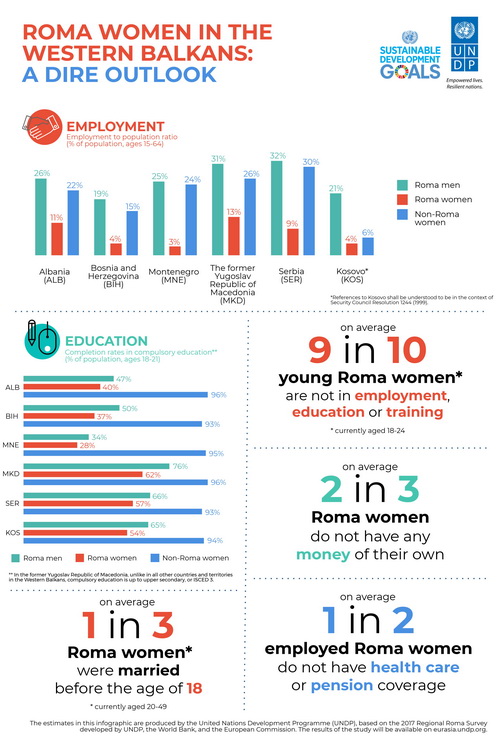The Regional study on Roma in the Western Balkans carried out in 2017 showed that marginalised Roma still face limited access to opportunities in all aspects of human development, such as basic rights, health, education, housing, employment and standard of living.
In Serbia, there is a wide gap between marginalised Roma and neighbouring non-Roma, especially wide for young people-marginalised Roma aged 18-24 are over half as likely to be in employment, education or training (27 percent), compared to 58 percent non-Roma youth. This has life-long implications, blocking further opportunities for decent employment. Marginalised Roma aged 15-64 are half as likely to be employed as neighbouring non-Roma.
In 2017, talking about the education, only 17 percent of marginalised Roma children aged 3-6 were enrolled in pre-primary education or above; the great majority of young marginalised Roma children were not at school. It is worth noting that the gap between Roma and non-Roma in Serbia is the second-largest in the Western Balkans. When it comes to the elementary school, the situation is somewhat better, and, even though the proportion of marginalised Roma children of compulsory school age who are enrolled in school is on the rise, and the enrollment rate is the highest in the Western Balkans, about 1 out of 6 marginalised Roma children of compulsory attendance age are still out of the education system. Despite significant improvements, over one-third of marginalised Roma aged 18-21 lack a basic education. In contrast, nearly all neighbouring non-Roma counterparts had this level of education. In the tertiary education segment, the gap between the Roma and non-Roma population in Serbia is the widest compared to all the Western Balkans countries. The completion rate in tertiary education is a shocking 1%, compared to 23% among the non-Roma.
Marginalised Roma in Serbia tend to have lower employment rates than neighbouring non-Roma. Just over one-fifth of marginalised Roma aged 15-64 were employed in 2017, versus 40 percent of their neighbouring non-Roma counterparts. Just one-third of marginalised Roma ages 15-64 participated in the labour market in 2017, down from 52 percent in 2011. The gap between the two groups doubled in the previous five years.
In the healthcare, a positive aspect is that the great majority of marginalised Roma have health insurance coverage in Serbia. However, the percentage of marginalised Roma aged 16 and over having reported that they have not accessed health services when needed, is much higher than that among neighbouring non-Roma, and comes to slightly more than one-fourth of the total sample. Still, there are some improvements in this area, with respect to 2011.
When it comes to the housing, access to electricity and piped water increased in 2017 for marginalised Roma and the gaps vis-à-vis neighbouring non-Roma are narrowing. At the same time, no collection of waste is still an issue affecting a larger share of the Roma population living in marginalised communities.
Nearly all marginalised Roma in Serbia now possess civil registration documents. In 2017, about 99 percent of the marginalised Roma population possessed birth certificates and 94 percent of those aged 16 and over had a national ID card.
The Regional survey on socio-economic position of marginalised Roma in Western Balkans was implemented in 2017 with support from the European Commission Directorate General for Neighbourhood and Enlargement Negotiations (DG NEAR), in cooperation with the World Bank, and in consultation with the EU’s Fundamental Rights Agency and other UN Agencies.
A total of 4,592 marginalised Roma households and 2,168 marginalized non-Roma households participated in the survey.
Supplementary UNDP research showed that Roma women are in particularly difficult position in the Western Balkans. On average, 9 in 10 Roma women are not in employment, education or training; 2 in 3 Roma women do not have any money of their own, while 1 in 2 employed Roma Women do not have health care or pension coverage. The issue of early marriage among marginalized Roma women is still present, and in this regard, Serbia is on the second place in the Western Balkans, following Albania. Forty percent of marginalized Roma women aged 20-49 in Serbia mentions getting married before the age of 18, compared to 9% of non-Roma women from the nighbouring marginalized communities, which in practice means that, on average, 1 in 3 Roma girls were married before the age of 18.
 (Source: www.rs.undp.org)
(Source: www.rs.undp.org)
The organizations and institutions behind the research hope that the comprehensive and continuous monitoring of the indicators of the position of Roma in society will contribute to better policy making and enable revision of existing strategies and programs for full inclusion of Roma and other marginalized groups in all the segments of the society.
At the same time, the data such as the one from the regional survey is needed to monitor the progress towards the 2030 Sustainable Development Agenda, and achievement of the global Sustainable Development Goals, in line with its crosscutting principle to “leave no one behind”.
Country Fact Sheets from the Regional Study may be found and downloaded at: www.eurasia.undp.org
Source: www.rs.undp.org
 Government of the Republic of Serbia
Government of the Republic of Serbia















 pdf [271 KB]
pdf [271 KB]
Leave a Comment